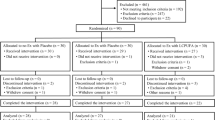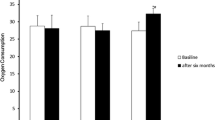Abstract
Objective
We investigated the effects of six months vitamin E administration on cognition evaluated by event-related potentials in exercising older subjects.
Design
Randomised controlled trial.
Setting
Retirement home in Antalya, Turkey.
Participants
Fifty-seven adults aged 60–85 years were randomly assigned to one of four groups: sedentary control (C), vitamin E (V), exercise training (E) and vitamin E under training (EV).
Intervention
V and EV groups were received vitamin E at a dose of 900 IU/day P.O. for 6 months. Trained groups were subjected to walking exercise involved 3 sessions per week for 6 months. Walking duration was gradually increased during 8 weeks, and stayed constant until the end of training period. Participants were begun walking at % 70 heart rate reserve for 20 min/day at the first two weeks, and walking duration was increased by 5 minutes/day of each week until subjects were reached a level of 50 min/day by week 8. Measurements Plasma vitamin E concentration, total antioxidant capacity and two parameters of event-related potentials namely P3 latency and amplitude were performed on all study groups both before and after training.
Results
Significant improvement in P3 latency was found in exercising groups. However, no significant differences were found between vitamin and other groups for P3 latency. Amplitude measurements were found unaltered among all groups.
Conclusion
We concluded that although six months training results improvement in P3 latency, vitamin E supplementation does not affect cognitive function evaluated by event-related potentials in older subjects.
Similar content being viewed by others
References
Kramer AF, Erickson KI. Capitalizing on cortical plasticity: influence of physical activity on cognition and brain function. Trends Cogn Sci 2007;11(8):342–348.
Chodzko-Zajko, W.J. and Moore, K.A. Physical fitness and cognitive functioning in aging. In: Exercise and Sport Sciences Reviews. Ed: Holloszy, J.O. Baltimore: Williams & Wilkins. 1994;95–220.
Dustman RE, Ruhling RO, Russell EM, Shearer DE, Bonekat HW, Shigeoka JW, Wood JS, Bradford DC. Aerobic exercise training and improved neurophysiological function of older individuals. Neurobiol Aging 1984;5:35–42.
Colcombe SJ, Erickson KI, Scalf PE, Kim JS, Prakash R, McAuley E, Elavsky S, Marquez DX, Hu L, Kramer AF. Aerobic exercise training increases brain volume in aging humans. J Gerontol A Biol Sci Med Sci 2006;61:1166–1170.
Nicola T. Lautenschlager; Kay L. Cox; Leon Flicker; et al. Effect of Physical Activity on Cognitive Function in Older Adults at Risk for Alzheimer Disease A Randomized Trial. JAMA. 2008;300(9):1027–1037.
Eggermont LHP, Milberg WP, Lipsitz LA, Scherder EJA, Leveille SG. Physical Activity and Executive Function in Aging: The MOBILIZE Boston Study. J Am Geriatr Soc. 2009;57(10):1750–1756.
Weuve J, Kang JH, Manson JE, Breteler MMB, Ware JH, Grodstein F. Physical activity, including walking, and cognitive function in older women. JAMA. 2004;292(12):1454–1461.
Kramer AF, Erickson KI, Colcombe SJ. Exercise, cognition, and the aging brain. J Appl Physiol 2006;101:1237–1242.
Kamijo, K., Hayashi, Y., Sakai, T., Yahiro, T., Tanaka, K., & Nishihira, Y. Acute effects of aerobic exercise on cognitive function in older adults. J Gerontol B Psychol Sci Soc Sci 2009;64B(3), 356–363.
Thomas A, Iacono D, Bonanni L, D’Andreamatteo G, Onofrj M. Donepezil, rivastigmine, and vitamin E in Alzheimer disease: a combined P300 event-related potentials/neuropsychologic evaluation over 6 months. Clin Neuropharmacol 2001;24(1):31–42.
Braverman ER, Chen THC, Schoolfield J, Martinez-Pons M, Arcuri V, Varshavskiy M, Gordon CA, Mengucci J, Blum SH, Meshkin B, Downs BW, Blum K. Delayed P300 latency correlates with abnormal Test of Variables of Attention (TOVA) in adults and predicts early cognitive decline in a clinical setting. Adv Ther 2006;23(4):582–600.
Meydani M. Antioxidants and cognitive function. Nutr Rev 2001;59(8 Pt 2):S75–S80.
Smith MA, Rottkamp CA, Nunomura A, Raina AK, Perry G. Oxidative stress in Alzheimer’s disease. Biochim Biophys Acta 2000;1502(1):139–144.
Christen Y. Oxidative stress and Alzheimer disease. Am J Clin Nutr 2000;71(2):621S–629S.
Carney JM, Starke-Reed PE, Oliver CN, Landum RW, Cheng MS, Wu JF, Floyd RA. Reversal of age-related increase in brain protein oxidation, decrease in enzyme activity, and loss in temporal and spatial memory by chronic administration of the spin-trapping compound N-tert-butyl-alpha-phenylnitrone. Proc Natl Acad Sci U S A 1991;88(9):3633–3636.
Naziroğlu M, Butterworth PJ. Protective effects of moderate exercise with dietary vitamin C and E on blood antioxidative defense mechanism in rats with streptozotocin-induced diabetes. Can J Appl Physiol 2005;30(2):172–185.
Kutlu M, Naziroğlu M, Simşek H, Yilmaz T, Sahap Kükner A. Moderate exercise combined with dietary vitamins C and E counteracts oxidative stress in the kidney and lens of streptozotocin-induced diabetic-rat. Int J Vitam Nutr Res. 2005 Jan;75(1):71–80. Int J Vitam Nutr Res 2005;75 (1):71–80.
Cheburini A, Martin A, Andres-Lacueva C, et al. Vitamin E levels, cognitive impairment and dementia in older persons: the InCHIANTI study. Neurobiol Aging 2005;26:987–994.
Cesari M, Pahor M, Bartali B, et al. Antioxidants and physical performance in elderly persons: the Invecchiare in Chianti (InCHIANTI) study. Am J Clin Nutr 2004;79:289–294.
Semba RD, Blaum C, Guralnik JM, Moncrief DT, Ricks MO, Fried LP. Carotenoid and vitamin E status are associated with indicators of sarcopenia among older women living in the community. Aging Clin Exp Res 2003;15:482–487.
Jessup JV, Horne C, Yarandi H, Quindry J. The effects of endurance exercise and vitamin E on oxidative stress in the elderly. Biol Res Nurs 2003;5:47–55.
Sacheck JM, Milbury PE, Cannon JG, Roubenoff R, Blumberg JB. Effect of vitamin E and eccentric exercise on selected biomarkers of oxidative stres in young and elderly men. Free Radic Biol Med 2003;34:1575–1588.
Nalbant O, Toktas N, Toraman NF, Ogus C, Aydin H, Kacar C, Ozkaya YG. Vitamin E and aerobic exercise: effects on physical performance in older adults. Aging Clin Exp Res 2009;21(2):111–121.
Ortega RM, Requejo AM, López-Sobaler AM, Andrés P, Navia B, Perea JM, Robles F. Cognitive function in elderly people is influenced by vitamin E status. J Nutr 2002;132(7):2065–2068.
Morris MC, Evans DA, Bienias JL, Tangney CC, Wilson RS. Vitamin E and cognitive decline in older persons. Arch Neurol 2002;59(7):1125–1132.
Foy CJ, Passmore AP, Vahidassr MD, Young IS, Lawson JT. Plasma chain-breaking antioxidants in Alzheimer’s disease, vascular dementia and Parkinson’s disease. QJM 1999;92(1):39–45.
Eker E, Turan Ertan T. Behavioral and Psychological Symptoms of Dementia in Eastern and Southeastern Europe and the Middle East. Int Psychogeriatr 2000;12:409–413.
Voorrips LE, Ravelli ACJ, Dongelmans PCA, Deurenberg P, Staveren WAV. A physical activity questionnaire for the elderly. Med Sci Sport Exerc 1991;23:974–979.
Freese R, Alfthan G, Jauhiainen M, Basu S, Erlund I, Salminen I, Aro A, Mutanen M. High intakes of vegetables, berries, and apples combined with a high intake of linoleic or oleic acid only slightly affect markers of lipid peroxidation and lipoprotein metabolism in healthy subjects. Am J Clin Nutr 2002;76(5):950–960.
Desai ID. Vitamin E analysis methods for animal tissues. Methods Enzymol 1984;105:138–147.
Heinze HJ, Münte TF, Kutas M, Butler SR, Naatanen R, Nuwer MR, Goodin DS. Cognitive event related potentials. The International Federation of Clinical Neurophysiology. Electroencephalogr Clin Neurophysiol 1999 (Supplement);52:91–97.
Wilmore JH, Costill DL. Physiology of sports and exercise. Champaign, IL: 1994. Human Kinetics.
American College of Sports Medicine. ACSM Position Stand on Exercise and Physical Activity for Older Adults. Med Sci Sports Exerc 1998;30:992–998.
Cruzat VF, Rogero MM, Borges MC, Tirapegui IJ. Current aspects about oxidative stress, physical exercise and supplementation. Rev Bras Med Esporte 2007;13:336–342.
Wu D, Han SN, Meydani M, Meydani SN. Effect of Concomitant Consumption of Fish Oil and Vitamin E on T Cell Mediated Function in the Elderly: A Randomized Double-Blind Trial. J Am Coll Nutr 2006;25(4):300–306.
Wittin LA, Lee L. Dietary levels of vitamin E and polyunsaturated fatty acids and plasma vitamin E. Am J Clin Nutr 1975:28:571–576.
Fatouros IG, Jamurtas AZ, Villiotou V et al. Oxidative stress responses in older men during endurance training and detraining. Med Sci Sport Exerc 2004;36:2065–2072.
Brennan LA, Morris GM, Wasson GR, Hannigan BM, Barnett YA. The effect of vitamin C or vitamin E supplementation on basal and H2O2-induced DNA damage in human lymphocytes. Br J Nutr 2000;84:195–202.
Pincemail J, Deby C, Camus G, Pirnay F, Bouchez R, Massaux L, Goutier R. Tocopherol mobilization during intensive exercise. Eur J Appl Physiol. 1988;57:189–191.
Bloomer RJ, Goldfarb AH, Wideman L, McKenzie MJ, Consitt LA. Effects of acute aerobic and anaerobic exercise on blood markers of oxidative stress. J Strength Cond Res. 2005;19:276–285.
Cao G, Prior RL. Comparison of different analytical methods for assessing total antioxidant capacity of human serum. Clin Chem 1998;44:1309–1315.
Ozkaya GY, Aydin H, Toraman FN, Kizilay F, Ozdemir O, Cetinkaya V Effect of strength and endurance training on cognition in older people. J Sports Sci Med 2005;4(3):300–313.
Carro E, Trejo LJ, Busiguina S, Torres AI. Circulating insulin-like growth factor 1 mediates the protective effects of physical exercise against brain insults of different etiology and anatomy. J Neurosci 2001;21:5678–5684.
Kamijo K, Nishihira Y, Hatta A, Kaneda T, Kida T, Higashiura T, Kuroiwa K. Changes in arousal level by differential exercise intensity. Clin Neurophysiol 2004;115:2693–2698.
Tecce JJ, Savignano-Bowman J, Meinbresse D. Contingent negative variation and the distraction — arousal hypothesis. Electroencephalogr Clin Neurophysiol 1976;41:277–286.
Sano M, Ernesto C, Klauber MR, Schafer K, Woodbury P, Thomas R, Grundman M, Growdon J, Thal LJ. Rationale and design of a multicenter study of selegiline and alpha-tocopherol in the treatment of Alzheimer disease using novel clinical outcomes. Alzheimer’s Disease Cooperative Study. Alzheimer Dis Assoc Disord 1996;10(3):132–140.
Masaki KH, Losonczy KG, Izmirlian G, Foley DJ, Ross GW, Petrovitch H, Havlik R, White LR. Association of vitamin E and C supplement use with cognitive function and dementia in elderly men. Neurology 2000;54(6):1265–1272.
Francis PT, Palmer AM, Snape M, Wilcock GK. The cholinergic hypothesis of Alzheimer’s disease: a review of progress. J Neurol Neurosurg Psychiatry 1999;66(2):137–147.
Author information
Authors and Affiliations
Corresponding author
Rights and permissions
About this article
Cite this article
Çetin, E., Top, E.C., Şahin, G. et al. Effect of vitamin e supplementation with exercise on cognitive functions and total antioxidant capacity in older people. J Nutr Health Aging 14, 763–769 (2010). https://doi.org/10.1007/s12603-010-0256-x
Received:
Accepted:
Published:
Issue Date:
DOI: https://doi.org/10.1007/s12603-010-0256-x




